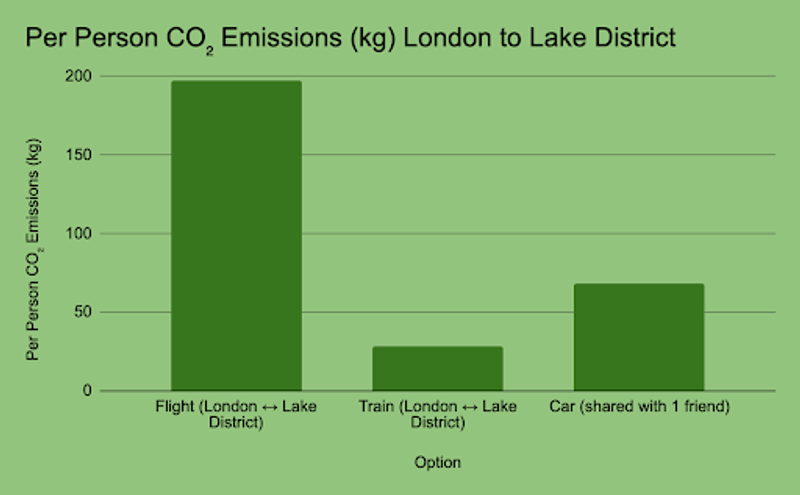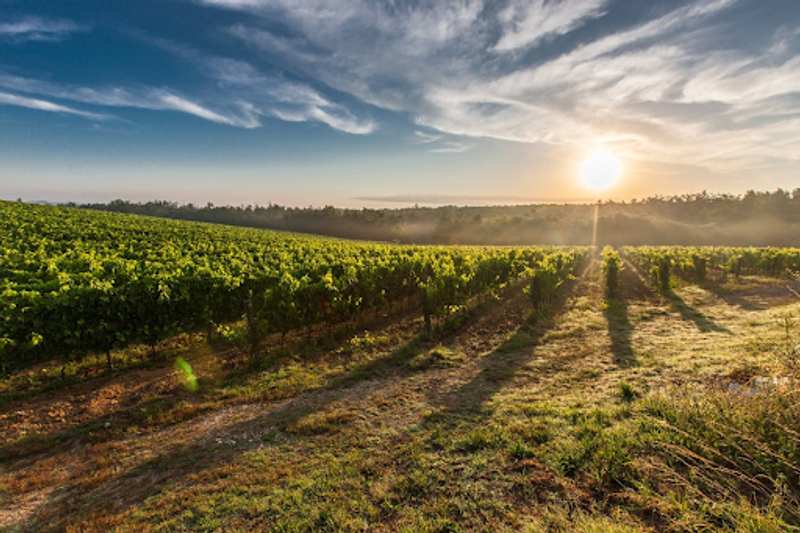We all love a weekend getaway. Whether you’re catching a quick flight, hopping on a train, or taking the car, your carbon footprint from even a short weekend break can add up, and how you travel makes all the difference
But behind that freedom and fun is something many of us don’t consider until we’re asked: What is the environmental cost of that trip? Specifically, what’s the carbon footprint of our short breaks?
This guide breaks it all down in simple, friendly language. We’ll explore the carbon footprint of your travel choices, how to reduce it, and how to offset it responsibly.
Because yes, you can still enjoy your adventures and be a more responsible, carbon footprint, travel-conscious explorer.
What Even is a Carbon Footprint?

Let’s start with the basics. A carbon footprint is the total amount of greenhouse gases (like carbon dioxide, methane, and nitrous oxide) released into the atmosphere because of your actions. It’s measured in units of carbon dioxide equivalents (CO₂e). When we talk about travel, we're mostly talking about CO₂ emissions that come from burning fuel be it aviation fuel, petrol, or diesel.
These gases trap heat in the atmosphere, contributing to global warming and climate change. So when you drive, fly, or even use electricity made from fossil fuels, you're adding to that invisible heat blanket.
That doesn’t mean you should stop travelling. Far from it. But understanding your carbon footprint is the first step toward something better: sustainable travel. It’s not about giving up holidays, it’s about making choices that are lighter on the planet without compromising your experience. That could mean taking the train instead of a short-haul flight, sharing car rides, choosing an electric vehicle when you can, or offsetting your emissions through credible, science-backed programmes. When you travel with your impact in mind, you’re not just exploring the world, you’re helping preserve it..
It's about balance, travelling in a way that brings joy without putting unnecessary pressure on our fragile planet.
The Weekend Trip Breakdown: Plane vs. Train vs. Car
So let’s look at some actual examples. Imagine you're planning a weekend away. You have three options:
- Fly from London to Lake district
- Take the train to the Lake District
- Drive to the Lake District with a friend
Let’s break down what each one means for the environment and your carbon footprint travel decisions.
Whether you’re catching a quick flight, hopping on a train, or taking the car, even your sustainable weekend break choice can make a big difference.
Option 1: Flight – London to Lake District (via Manchester Airport + local transit)
- Distance: Approx. 800 km round trip
- Emissions per passenger-km (UK domestic flights): 246 g CO₂
- Total emissions: 0.246 kg × 800 km = ~197 kg CO₂ per person
That’s just for one person. And it doesn’t include the extra warming effect of planes flying at high altitudes, which increases the warming potential significantly, sometimes doubling the climate impact of flights.
Option 2: Train – London to the Lake District
- Distance: Approx. 800 km round trip
- Emissions per passenger-km (UK rail): 35 g CO₂
- Total emissions: 0.035 kg × 800 km = ~28 kg CO₂ per person
A dramatic difference, right? The train emits only about 13% of the CO₂ that the flight does. And that's just the emissions story. Trains are also more efficient in land use and less disruptive to ecosystems.
Option 3: Car – Drive to the Lake District with a friend
- Distance: Approx. 800 km round trip
- Emissions (petrol car): 170 g CO₂ per km
Total emissions: 0.170 kg × 800 km = ~136 kg CO₂ total (or 68 kg per person if shared)
Of course, this changes depending on the fuel efficiency of your vehicle and whether you're driving solo. If you’re in an electric car charged on renewable energy, the emissions could drop close to zero.

Train Wins the Eco Race

Among all the travel options (plane, car, train), the train is currently the best, most valuable, or most effective choice when it comes to sustainable (eco-friendly) travel.
- Less stressful (no airport security lines!)
- More scenic (you’re gliding past mountains and lakes)
- More comfortable (stretch your legs, grab a snack, read a book)
Trains aren’t just better for the planet, they’re often better for you.
And unlike airports, which are usually on the outskirts of cities, train stations tend to bring you right into the heart of your destination, saving time, transfers, and taxi fares.
So whenever it’s an option, the train is not only a more climate-friendly choice it’s often the smarter, simpler one for your next eco-friendly travel plan or sustainable weekend break.And many UK train routes are increasingly powered by electricity, some of which comes from renewable sources. Some new high-speed rail systems aim to run entirely on renewable energy by 2035.
Even Eurostar reports that its carbon footprint is 96% lower than flying the same route. So whenever the train is an option, it's almost always the more climate-friendly choice.
How to Offset the Carbon Footprint from Your Flight (Without Greenwashing)
Offsetting means funding projects that reduce or remove greenhouse gases elsewhere to balance out the emissions you create when flying. Think tree planting, wind energy, or restoring UK peatlands.
But here’s the catch: not all offsets are equal. Some are poorly managed, unverifiable, or don’t lead to real reductions. This is where “greenwashing” comes in: making something sound eco-friendly when it really isn’t.
How to Choose Good Offsets:
- Look for projects certified by standards like Gold Standard, Verified Carbon Standard (VCS), or the UK Woodland Carbon Code
- Prioritise transparent platforms that show where your money goes. Eg:
- Support projects with long-term community and ecological benefits. Eg:
Some trusted UK or global platforms include:
4 Simple Ways to Fly Smarter and Offset Your Impact
1. Use a Carbon Footprint Calculator
These tools help you figure out exactly how much CO₂ your trip produces:
2. Community-based renewable energy: Platforms like Carbon Footprint Ltd offer UK-based offsets that support wind, solar, and hydro energy projects in addition to international schemes.
3.Peatland restoration: UK peatlands store more carbon than all UK forests combined. The IUCN UK Peatland Programme works on restoring these natural carbon sinks to protect biodiversity and reduce emissions.
3. Fly Smarter
Here are a few easy tips that go a long way:
- Book economy class (less space = more efficient per passenger)
- Choose direct flights (take-offs and landings burn the most fuel)
- Pack light (every extra kilo = more fuel burned)
Let’s Talk About Cars
If you're driving, you can still reduce your carbon footprint with some thoughtful choices:
- Carpool: Invite friends. Sharing rides instantly halves your impact.
- Drive efficiently: Inflate tyres properly, avoid hard acceleration, and stick to steady speeds.
- Choose greener vehicles: Hybrid and electric cars have far lower emissions, especially when charged with renewable energy.
- Offset your fuel: Use the same platforms as with flights. Every litre of petrol you burn produces about 2.3 kg of CO₂.
And remember, keeping your car well-maintained makes it not only more efficient but safer too.
How to Travel Greener on the Ground

Once you arrive at your destination, your travel habits can still make a big difference:
- Stay local: Walk, rent a bike, or use public transport to explore
- Eat local and seasonal: Reduces food miles and supports local communities
- Stay sustainably: Look for hotels or B&Bs that hold green certifications like Green Key or EarthCheck
- Say no to single-use: Bring your reusable water bottle, coffee cup, tote bags, and cutlery
It’s all about those small shifts that add up over time.
Final Takeaways
Travel is one of life’s great joys. But it doesn’t have to come at the planet’s expense.
If we all make eco-friendly travel choices, even for short getaways or a sustainable weekend break we start building a future where adventure and responsibility go hand in hand.
- Know your impact: Use a carbon calculator before you book.
- Choose better transport: Trains are almost always greener than flights or solo car trips.
- Offset the rest: Use reliable programs to neutralize what you can’t reduce.
- Support sustainable businesses: Stay, shop, and eat with locals who care about the environment.
- Spread the word: Share what you learn and inspire others to travel more mindfully.
